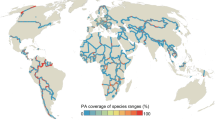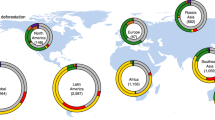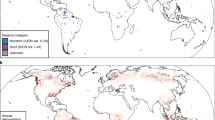Abstract
Globalization increasingly allows countries to externalize the environmental costs of land use, including biodiversity loss1. So far, we have a very incomplete understanding of how countries cause biodiversity loss outside their own borders through their demand for agricultural and forestry products grown in other countries2. Here we quantify the global range losses to forest vertebrates from 2001 to 2015 caused by deforestation attributable to 24 developed countries by means of their consumption of products obtained through global supply chains. We show that these driver countries are responsible for much greater cumulative range loss to species outside their own borders than within them. These international impacts were concentrated geographically, allowing us to map global hotspots of outsourced losses of biodiversity. Countries had the greatest external impacts on species occurring in nearby regions. However, in a few cases, developed countries also inflicted disproportionate harm on vertebrates in distant countries.
This is a preview of subscription content, access via your institution
Access options
Access Nature and 54 other Nature Portfolio journals
Get Nature+, our best-value online-access subscription
$32.99 / 30 days
cancel any time
Subscribe to this journal
Receive 51 print issues and online access
$199.00 per year
only $3.90 per issue
Buy this article
- Purchase on SpringerLink
- Instant access to full article PDF
Prices may be subject to local taxes which are calculated during checkout




Similar content being viewed by others
Data availability
Data on forest cover and forest loss from the Hansen Global Forest Change v.1.7 (2000–2019) dataset are available in an online repository at https://earthenginepartners.appspot.com/science-2013-global-forest/download_v1.7.html (ref. 17). Land-use attribution data are available from the authors of ref. 20 on request. Those data were calculated using data from the MRIO database (https://worldmrio.com), the previously mentioned forest cover and loss data, FAOSTAT (https://www.fao.org/faostat) and EliScholar (https://elischolar.library.yale.edu/yale_fes_data), all of which are publicly available. Range map data are available at the following online repositories: BirdLife International (http://datazone.birdlife.org/species/requestdis) and IUCN (https://www.iucnredlist.org/resources/spatial-data-download). Processed species-level data are available at Zenodo (https://doi.org/10.5281/zenodo.14030743)77.
Code availability
The code necessary to replicate the analysis and figures can be found in the following GitHub repository: https://github.com/AlexWiebe/Outsourced-Biodiversity-Loss.
References
Lenzen, M. et al. International trade drives biodiversity threats in developing nations. Nature 486, 109–112 (2012).
Kuemmerle, T., Kastner, T., Meyfroidt, P. & Qin, S. in Telecoupling: Exploring Land-Use Change in a Globalised World (eds Friis, C. & Nielsen, J. O.) 281–302 (Palgrave Macmillan, 2019).
Pimm, S. L. et al. The biodiversity of species and their rates of extinction, distribution, and protection. Science 344, 1246752 (2014).
Pimm, S. L., Russell, G. J., Gittleman, J. L. & Brooks, T. M. The future of biodiversity. Science 269, 347–350 (1995).
Wilcove, D. S., Rothstein, D., Dubow, J., Phillips, A. & Losos, E. Quantifying threats to imperiled species in the United States: assessing the relative importance of habitat destruction, alien species, pollution, overexploitation, and disease. Bioscience 48, 607–615 (1998).
Grooten, M. & Almond, R. E. A. Living Planet Report—2018: Aiming Higher (WWF, 2018).
Bjelle, E. L., Kuipers, K., Verones, F. & Wood, R. Trends in national biodiversity footprints of land use. Ecol. Econ. 185, 107059 (2021).
Hoang, N. T. et al. Mapping potential conflicts between global agriculture and terrestrial conservation. Proc. Natl Acad. Sci. USA 120, e2208376120 (2023).
Wilting, H. C., Schipper, A. M., Bakkenes, M., Meijer, J. R. & Huijbregts, M. A. J. Quantifying biodiversity losses due to human consumption: a global-scale footprint analysis. Environ. Sci. Technol. 51, 3298–3306 (2017).
Malik, A., Lenzen, M. & Fry, J. Biodiversity impact assessments using nested trade models. Environ. Sci. Technol. 56, 7378–7380 (2022).
Kitzes, J. et al. Consumption-based conservation targeting: linking biodiversity loss to upstream demand through a global wildlife footprint. Conserv. Lett. 10, 531–538 (2017).
Moran, D. & Kanemoto, K. Identifying species threat hotspots from global supply chains. Nat. Ecol. Evol. 1, 23 (2017).
Courchamp, F., Berec, L. & Gascoigne, J. Allee Effects in Ecology and Conservation (Oxford Univ. Press, 2008).
Caughley, G. Directions in conservation biology. Conserv. Biol. 82, 195–210 (1994).
Soule, M. E. & Wilcove, B. A. (eds) Conservation Biology: An Evolutionary–Ecological Perspective (Sinauer, 1980).
Brook, B. W., Sodhi, N. S. & Bradshaw, C. J. A. Synergies among extinction drivers under global change. Trends Ecol. Evol. 23, 453–460 (2008).
Levers, C. & Müller, D. in Telecoupling: Exploring Land-Use Change in a Globalised World (eds Friis, C. & Nielsen, J. O.) 89–113 (Palgrave Macmillan, 2019).
Mayer, A. L., Kauppi, P. E., Angelstam, P. K., Zhang, Y. & Tikka, P. M. Importing timber, exporting ecological impact. Science 308, 359–360 (2005).
Smith, S. B., Gotoh, T. & Greenwood, P. L. Current situation and future prospects for global beef production: overview of special issue. Asian-Australasian J. Anim. Sci. 31, 927–932 (2018).
Hoang, N. T. & Kanemoto, K. Mapping the deforestation footprint of nations reveals growing threat to tropical forests. Nat. Ecol. Evol. 5, 845–853 (2021).
Grenyer, R. et al. Global distribution and conservation of rare and threatened vertebrates. Nature 444, 93–96 (2006).
Data Zone (BirdLife International); http://datazone.birdlife.org/species/requestdis (Accessed 31 January 2023).
Red List of Threatened Species (IUCN, 2022); https://www.iucnredlist.org/resources/spatial-data-download (Accessed 31 January 2023).
Hansen, M. C. et al. High-resolution global maps of 21st-century forest cover change. Science 342, 850–853 (2013).
Myers, N., Mittermeier, R. A., Mittermeier, C. G., da Fonseca, G. A. B. & Kent, J. Biodiversity hotspots for conservation priorities. Nature 403, 853–858 (2000).
May, R. M. The future of biological diversity in a crowded world. Curr. Sci. 82, 1325–1331 (2002).
Andriamparany, J. N., Heritiana, J. T., Hänke, H., Kunz, S. & Schlecht, E. Market supply of livestock and animal products in north-eastern Madagascar—the role of the vanilla boom. Sci. Afr. 19, e01526 (2023).
Hänke, H. et al. Socio-economic, Land Use and Value Chain Perspectives on Vanilla Farming in the SAVA Region (North-eastern Madagascar): The Diversity Turn Baseline Study (DTBS). (Georg-August-Universität Göttingen, 2018).
Boone, C., Kaila, H. K. & Sahn, D. E. Posh spice or scary spice? The impacts of Madagascar’s vanilla boom on household well-being. SSRN Electron. J. https://doi.org/10.2139/ssrn.4085179 (2022).
Burivalova, Z., Şekercioǧlu, Ç. H. & Koh, L. P. Thresholds of logging intensity to maintain tropical forest biodiversity. Curr. Biol. 24, 1893–1898 (2014).
Pendrill, F. et al. Disentangling the numbers behind agriculture-driven tropical deforestation. Science 377, eabm9267 (2022).
Kadoya, T., Takeuchi, Y., Shinoda, Y. & Nansai, K. Shifting agriculture is the dominant driver of forest disturbance in threatened forest species’ ranges. Commun. Earth Environ. 3, 108 (2022).
Woodward, F. I., Lomas, M. R. & Kelly, C. K. Global climate and the distribution of plant biomes. Philos. Trans. R. Soc. B 359, 1465–1476 (2004).
Mills, J. H. & Waite, T. A. Economic prosperity, biodiversity conservation, and the environmental Kuznets curve. Ecol. Econ. 68, 2087–2095 (2009).
Andreoni, J. & Levinson, A. The simple analytics of the environmental Kuznets curve. J. Public Econ. 80, 269–286 (2001).
Grossman, G. M. & Krueger, A. B. Economic growth and the environment. Q. J. Econ. 110, 353–377 (1995).
Naidoo, R. & Adamowicz, W. L. Effects of economic prosperity on numbers of threatened species. Conserv. Biol. 15, 1021–1029 (2001).
McPherson, M. A. & Nieswiadomy, M. L. Environmental Kuznets curve: threatened species and spatial effects. Ecol. Econ. 55, 395–407 (2005).
Dietz, S. & Adger, W. N. Economic growth, biodiversity loss and conservation effort. J. Environ. Manag. 68, 23–35 (2003).
Tevie, J., Grimsrud, K. M. & Berrens, R. P. Testing the environmental kuznets curve hypothesis for biodiversity risk in the US: a spatial econometric approach. Sustainability 3, 2182–2199 (2011).
Otero, I. et al. Biodiversity policy beyond economic growth. Conserv. Lett. 13, e12713 (2020).
Mozumder, P., Berrens, R. P. & Bohara, A. K. Is there an environmental Kuznets curve for the risk of biodiversity loss? J. Dev. Areas 39, 175–190 (2006).
USA Location Map (Geographic.Media, 1970); https://geographic.media/north-america/usa/usa-maps/usa-location-map.
Cattle & Beef Statistics & Information (USDA, 2022).
Major Uses of Land in the United States, 2012 (USDA, 2012).
Wunsch, N.-G. Palm Oil Consumption in the United States from 2000 to 2022 (Statista, 2023); https://www.statista.com/statistics/301032/palm-oil-consumption-united-states/#:~:text=Americans.
Neate-Clegg, M. H. C. & Şekercioǧlu, Ç. H. Agricultural land in the Amazon basin supports low bird diversity and is a poor replacement for primary forest. Condor 122, duaa020 (2020).
Ritchie, H., Spooner, F. & Roser, M. Forests and Deforestation (OurWorldinData, 2021); https://ourworldindata.org/forests-and-deforestation.
Grain: World Markets and Trade (USDA, 2022) (Accessed on 31 August 2023).
FAOSTAT: Crops and Livestock Products (FAO, 2022); https://www.fao.org/faostat/en/#data/QCL (Accessed on 31 August 2023).
Classification Schemes (IUCN, 2022); https://www.iucnredlist.org/resources/classification-schemes (Accessed on 31 January 2023).
Hansen, A. et al. Global humid tropics forest structural condition and forest structural integrity maps. Sci. Data 6, 232 (2019).
Moran, D. & Wood, R. Convergence between the Eora, Wiod, Exiobase, and Openeu’s consumption-based carbon accounts. Econ. Syst. Res. 26, 245–261 (2014).
Godar, J., Persson, U. M., Tizado, E. J. & Meyfroidt, P. Towards more accurate and policy relevant footprint analyses: tracing fine-scale socio-environmental impacts of production to consumption. Ecol. Econ. 112, 25–35 (2015).
Lenzen, M. et al. Compiling and using input-output frameworks through collaborative virtual laboratories. Sci. Total Environ. 485–486, 241–251 (2014).
Ritchie, H. & Roser, M. Land Use (Our World in Data, 2019); https://ourworldindata.org/land-use.
Curtis, P. G., Slay, C. M., Harris, N. L., Tyukavina, A. & Hansen, M. C. Classifying drivers of global forest loss. Science 361, 1108–1111 (2018).
Hijmans, R. terra: Spatial data analysis. R package version 1.7-29 (2023).
Pebesma, E. Simple features for R: standardized support for spatial vector data. R J. 10, 439–446 (2018).
Pebesma, E. & Bivand, R. Spatial Data Science: With Applications in R (Chapman and Hall/CRC, 2023).
Hijmans, R. raster: Geographic data analysis and modeling. R package version 3.6-20 (2023).
Ross, N. fasterize: Fast polygon to raster conversion. R package version 1.0.4 (2022).
Lamiguero, O. P. & Hijmans, R. rasterVis. R package version 0.51.5 (2023).
Bivand, R. & Rundel, C. rgeos: Interface to geometry engine—open source (GEOS). R package version 0.6-4 (2023).
Bivand, R., Keitt, T. & Rowlingson, B. rgdal: Bindings for the geospatial data abstraction library. R package version 1.6-7 (2023).
Csárdi, G. et al. remotes: R package installation from remote repositories, including GitHub. R package version 2.4.2 (2021).
Wickham, H. et al. Welcome to the tidyverse. J. Open Source Softw. 4, 1686 (2019).
Wickham, H., François, R., Henry, L., Müller, K. & Vaughan, D. dplyr: A grammar of data manipulation. R package version 1.1.2 (2023).
Wickham, H. ggplot2: Elegant Graphics for Data Analysis (Springer, 2016).
Massicotte, P. & South, A. rnaturalearth: World map data from Natural Earth. R package version 0.3.3 (2023).
South, A. rnaturalearthdata: World vector map data from Natural Earth used in rnaturalearth. R package version 0.1.0 (2017).
South, A., Michael, S. & Massicotte, P. rnaturalearthhires: High resolution world vector map data from Natural Earth used in rnaturalearth. R package version 0.2.1 (2023).
Gearty, W. & Chamberlain, S. rredlist: IUCN Red list client. R package version 0.7.1 (2022).
Becker, R. A., Wilks, A. R., Brownrigg, R., Minka, T. P. & Deckmyn, A. maps: Draw geographical maps. R package version 3.4.2 (2023).
South, A. rworldmap: A new R package for mapping global data. R J. 3, 35–43 (2011).
Stahel, W. Statistische Datenanalyse: Eine Einführung für Naturwissenschaftler (Vieweg+Teubner, 2008).
Wiebe, R. A. & Wilcove, D. S. Processed species-level data for ‘Global biodiversity loss from outsourced deforestation’ [Data set]. Zenodo https://doi.org/10.5281/zenodo.14030743 (2024).
Acknowledgements
We would like to thank C. Tarnita, C. Riehl, S. Robinson and Y. Zeng for offering valuable perspectives that informed the design and analyses of the study; N.T. Hoang and K. Kanemoto for providing access to their data; and the High Meadows Foundation and Princeton University for their support of this work.
Author information
Authors and Affiliations
Contributions
R.A.W. conceived of the study and R.A.W. and D.S.W. developed the methodology. R.A.W. conducted the data analysis and wrote the initial draft, with both authors contributing to subsequent revisions.
Corresponding author
Ethics declarations
Competing interests
The authors declare no competing interests.
Peer review
Peer review information
Nature thanks Jean-Francois Bastin, Holger Kreft, Manfred Lenzen and the other, anonymous, reviewer(s) for their contribution to the peer review of this work.
Additional information
Publisher’s note Springer Nature remains neutral with regard to jurisdictional claims in published maps and institutional affiliations.
Extended data figures and tables
Extended Data Fig. 1 Cumulative absolute habitat loss attributable to each driver country.
Values shown are the cumulative contributions of each driver country to habitat loss of forest-obligate vertebrates (km2), separated by outsourced (red) and domestic (blue) components.
Extended Data Fig. 2 Cumulative domestic and outsourced range loss, shown together for direct comparison.
Values shown are total contributions of driver countries to habitat loss of forest-obligate vertebrates (units of species range equivalents), separated by domestic (blue) and outsourced (red) components. All countries have nonzero domestic losses except for Saudi Arabia, but those losses are very small in some countries and not visible in this figure.
Extended Data Fig. 3 Magnitude of international impacts relative to domestic impacts.
Values shown are the natural logarithm of the ratio of cumulative international to domestic range loss attributable to driver countries.
Extended Data Fig. 4 Median contributions to range loss across all individual species.
Values shown are the median contributions to species’ range loss of each driver country, as a percentage of the total range loss of those species, internationally (red) and domestically (blue).
Extended Data Fig. 5 Hotspots of attributable biodiversity loss by country (alphabetical order: Argentina - India).
Maps of the distribution of forest vertebrate biodiversity loss attributable via consumption-driven deforestation to 24 driver countries. Pixel values are the sum of species present in that pixel, weighted by the proportion of their ranges lost and attributable to a given driver country (units of species range equivalents). Credit: Made with Natural Earth (https://www.naturalearthdata.com).
Extended Data Fig. 6 Hotspots of attributable biodiversity loss by country (alphabetical order: Indonesia - Saudi Arabia).
Maps of the distribution of forest vertebrate biodiversity loss attributable via consumption-driven deforestation to 24 driver countries. Pixel values are the sum of species present in that pixel, weighted by the proportion of their ranges lost and attributable to a given driver country (units of species range equivalents). Credit: Made with Natural Earth (https://www.naturalearthdata.com).
Extended Data Fig. 7 Hotspots of attributable biodiversity loss by country (alphabetical order: Singapore - United States of America).
Maps of the distribution of forest vertebrate biodiversity loss attributable via consumption-driven deforestation to 24 driver countries. Pixel values are the sum of species present in that pixel, weighted by the proportion of their ranges lost and attributable to a given driver country (units of species range equivalents). Credit: Made with Natural Earth (https://www.naturalearthdata.com).
Extended Data Fig. 8 Global hotspots of long-distance biodiversity loss attributable to all driver countries combined.
Species-country data are included if the magnitude of attributable range loss exceeds the predicted values given the distance between that species’ range and the driver country. Thus, this map reflects the global distribution of exceptionally strong impacts of countries given their distance to species. Credit: Made with Natural Earth (https://www.naturalearthdata.com).
Extended Data Fig. 9 Distribution of outsourced impacts to Critically Endangered species.
The distribution shows frequencies of species-specific values of range loss attributable to the combined international effects of all driver countries, for all Critically Endangered species.
Supplementary information
Supplementary Information
Methods and discussion of a sensitivity analysis, testing the sensitivity of our primary results to potential errors in forest cover data by comparing them with those calculated using an alternative dataset.
Rights and permissions
Springer Nature or its licensor (e.g. a society or other partner) holds exclusive rights to this article under a publishing agreement with the author(s) or other rightsholder(s); author self-archiving of the accepted manuscript version of this article is solely governed by the terms of such publishing agreement and applicable law.
About this article
Cite this article
Wiebe, R.A., Wilcove, D.S. Global biodiversity loss from outsourced deforestation. Nature 639, 389–394 (2025). https://doi.org/10.1038/s41586-024-08569-5
Received:
Accepted:
Published:
Issue date:
DOI: https://doi.org/10.1038/s41586-024-08569-5
This article is cited by
-
Earth observation as enabler for implementing the EU regulation on deforestation-free products
npj Climate Action (2025)



